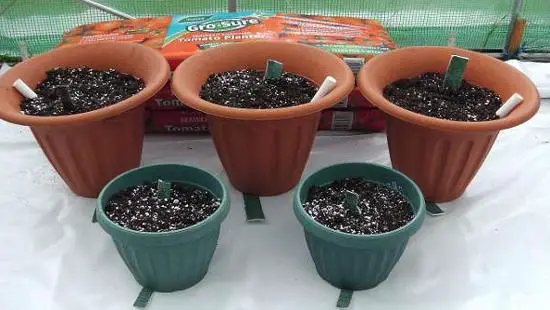Growing Tomatoes In Large Pots
There’s a great feeling of relief when planting tomato plants into their final growing position – a feeling that they’ve finally made it!
After months of special care, potting on and moving trays of seedlings from one position to another, it feels like the job is almost done. However, in some ways, it’s only just beginning!
Feeding, pruning and disease prevention will keep us fully occupied for the rest of the growing season!
Optimisation For Large Pots
The balance between moisture and air capacity.

A standard large pot or container can of course be divided into three levels of top middle and bottom.
Each layer should complement the needs of the plant’s roots.
Top Two Inches
The top layer is where most of the oxygen is absorbed by the surface roots.
It is also fairly dry because of moisture evaporation and water flows downwards.
Middle
This is the largest area of a pot where both moisture, air and nutrients are in balance with each other – hopefully!
Bottom Two Inches
Owing to compaction and excess moisture, when watered from below, the bottom two inches pose the biggest challenge.
- Potential water logging that creates bacteria which attacks the root system.
- Poor air capacity owing to compaction and saturation.
- Build up of nutrient salts that can be harmful to the roots and produce unwanted results in the plant and fruit.
In order to avoid some of the possible problems that can arise, here are a few tips on how to best optimise these three levels or pot areas.
Top Level
The dry(ish) soil at the surface is good – it helps roots absorb oxygen.
Remove lower leaf branches and any dead leaves on the surface to keep a good air flow at the soil surface. This will help increase oxygen intake and help prevent disease.
When potting, remove bottom few branches and pot lower in the soil.
Middle Level
This area should contain a mix of compost and perlite or media that will hold moisture and air.
The moisture holding capacity of compost varies widely depending on what’s in it!
John Innes is a recipe that contains clay which holds moisture very well.
John Innes also contains sand and grit which adds air and drainage owing to the gaps between the sand and grit particles. It has the benefits of multi-pupose with perlite added!
One way of getting more air into the middle area of a large pot or container is by using an air pipe.
This is particularly good for getting air to the roots. One of the big disadvantages of using pots is their small surface area – compared to growing directly in the ground.
The Air Pipe
What Is An Air Pipe?
An air pipe is a plastic or rubber pipe that runs vertically from the surface to the bottom of a large pot.
An air pipe allows air down into the mid and lower levels of a pot and is added when the pot is filled with compost.

Holes are drilled in the side of the pipe to allow air into the root zone – from top to bottom. An old length of hose pipe or any plastic tubing will do – as long as there are plenty of small holes to allow oxygen into the roots and other gasses to escape!

As we know, a good oxygen supply to the roots means quicker, healthier growth and a bigger yield.
Soil Surface and Root Capping
One of the few disadvantages with growing tomatoes in large pots and containers is that the surface area is limited.
Roots take oxygen through the soil surface, so the less surface area there is, the less access to oxygen plants have.
This is especially relevant for a mature tomato plant that has been in a large pot for some time.
Fine roots circle at the soil surface creating a dense cap that prevents oxygen from entering into the root zone below. As we know, roots need plenty of oxygen for energy (respiration), without it, plants run out of steam.
One way to avoid root capping is to use air pots or fabric pots which allow air in through the sides. Of course the air pipe works very well too!
The Bottom Level
This is the danger area where harmful bacteria can breed and damage a plant’s roots.
If the container/pot is sitting in a tray, make sure that water is fully absorbed and not left for long periods.
A pot sat above a tray of water on blocks with a wick (as photo above) will access water/nutrients without the soil becoming saturated.
The use of capillary matting strips can help take moisture from the lowest level to the area above.
This is particularly helpful in soil with poor capillary action or when using high sided pots.
If using perlite, have the greatest amount at the bottom level where air is most needed.
Clay Pebbles
A layer of clay pebbles at the surface and bottom of a pot helps for reasons stated above.
When can plants be left out overnight?
In the UK, it should be safe to plant outside from mid May onwards – the end of May in Scotland.
It’s good to “harden off” plants by getting them used to being outside where light levels are higher, the temperature range is greater and the breeze/wind plays a factor too.
That’s it for this week.
I hope all your plants are doing well!
Regards,
Nick

Diana Winfield
Have 2 plants F1 Red Profusion in 4 inch pots from garden centre looking very healthy with tomatoes on them I put outside each day . I want to grow them outdoors should I pot on again first and when can I plant out . Also growing Sweet Pea Currant from seed any tips on these ?
Thanks
Di
Nick
Hi Diana, SPC are best grown in large pots so they can trail over the sides if necessary. They can be grown as an uright variety but because they are small toms, they don’t need all the plant’s energy directed to one stem, as in a tall cordon variety.
Diana Winfield
Hi Nick I have 2 F1 Red Profusion plants bought from garden centre in 4inch pots looking very healthy , actually got tomatoes on them , that I want to grow outside . Have been taking outside in day and bringing indoors at night . Should I pot on before final planting outdoors and when do you think it’s ok to put out ?
Regards
Di
PS
Bought Gardeners Delight seeds from Wilkinson weeks ago nurtured them as you suggested and they looked very healthy I then fed them root it and repotted and they all died !!! Also growing Sweet Pea Currant from seed any tips on these ?
Nick
Hi Diana, You can plant out from the middle of May if you are in the UK and put them into their final large pot then.
I’m surprised that the Gardener’s Delight plants died … if the Root it was diluted correctly then it is likely to be a soil or over watering problem.
Jessie Allaway
Hi Nick,
We have been having a heatwave here for a couple of weeks so different problems. Having to shunt stuff about to give them some relief from the heat. Not a problem we have all that often I must say! Black Krim and Purple Ukrainians going into final pots today and almost all others ready for same are sitting on the starting blocks waiting on me going on a fifth (or is it sixth) compost buying trip.
I remember the man who used tiny pots and that seemed a very good idea – saving on compost and petrol! I tried it on one plant at the time and it was a complete failure. I assume everything has to be very tightly controlled for that system and I’m not that professional I’m afraid. Thanks for another interesting newsletter.
Nick
Hi Jess, you are right about everything having to be right when growing in small pots … the man in question was growing similar to a hydroponic approach with feeding at every watering – if I remember correctly!
Robert Smith
Hello Nick, Really enjoy your weekly bulletins, very educational, you mentioned “air pipes” to enable oxygen to get to the plant roots, would these be useful with the Quadgrow pots as well ?
Nick
Hi Robert, air pipes work well with the Quadgrow pots. Also, roots grow down into the reservoir so they also have a pocket of air between the water surface and the pot bottoms.
Rhys Jaggar
Hi Nick
Another challenge right now is strong easterly winds – plants need tight tying to sticks and being leaned against a wall which will not let plants in smaller pots get blown over.
Biggest challenge the last three weeks has been giving just enough water, not too much to rapidly growing plants in warm indoor rooms which only get 5hrs sunshine a day. A few have got leggy (Black Cherry the worst, then Tigerella), most are OK.
Every season has its new challenges!
Nick
Hi Rhys,
It’s quite windy where I am too – hopefully we have some better weather on the horizon.
I’ve spent some of this morning potting a few Mountain Magic and Brandy Boy varieties into their final pots. It’s amazing how much compost we can get through at this time of the season!
Rhys Jaggar
I am about to pot up my Super Marmandes, Tigerellas and Black Cherries. Hopefully I can hold off on the rest until 14th, as warmer weather appears to be on the horizon (16-17 by day, 9-10 by night).
Funnily enough, the lesson of this year is that the better you get at tomato growing, the later you can leave sowing. Seven or eight weeks from sowing to final pot means early April sowing and late May final pot. Even my 10th March sowings are ready a bit early this cool May….
Nick
It’s amazing how quickly tomato plants grow when given the right conditions!
Alex
Hi Nick, Great info as always. What do you think about growing in Terracota pots? I’ve heard they are good as they are fairly porous and allow some gas exchange through their surface?
Nick
Hi Alex, I know of one gardener who grows his tomatoes in Terracota pots with fantastic results – he even uses smaller size pots!
Fabric smart/dirt pots are also good and so are air pots.